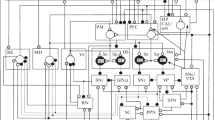The effects of injection of L-glutamate into the medial septal area on epileptogenesis associated with stimulation of the perforant pathway were studied in conscious guinea pigs. EEG field potentials were recorded in the hippocampus and medial septal area in the initial state and on formation of epileptic foci in animals given physiological saline (controls) or L-glutamate (glutamate group) into the medial septal area. Administration of glutamate enhanced the theta rhythm in both structures. During kindling in animals given glutamate, there was significantly earlier onset of the convulsive state and secondary epileptiform discharges than in controls. As the epileptic focus formed, sharp weakening of theta oscillations was seen in all animals, though onset was much earlier in the glutamate group. The correlation between the hippocampal and septal EEG decreased sharply in animals given glutamate, while changes in controls were minor. These results are of value in deciphering the mechanisms of temporal epilepsy.
Similar content being viewed by others
References
E. N. Karavaev, I. Yu. Popova, and V. G. Kichigina, “The nicotinic receptor blocker hexamethonium alters neuron responses to glutamate in the medial septal area of the ground squirrel brain in vitro,” Zh. Vyssh. Nerv. Deyat., 57, No. 1, 78–91 (2007).
V. V. Sinelnikova, I. Yu. Popova, and V. F. Kichigina, “Correlational relationships between the hippocampus and medial septal area and their changes during epileptogenesis,” Zh. Vyssh. Nerv. Deyat., 58, No. 3, 391–396 (2008).
J. N. Armstrong and B. A. MacVicar, “Theta-frequency facilitation of AMPA receptor-mediated synaptic currents in the principal cells of the medial septum,” J. Neurophysiol., 85, 1709–1718 (2001).
L. V. Colon, M. T. Castaneda, S. Hernandez, and T. Reyna, “Glutamate-immunoreactive neurons from the septal region project to the hippocampus,” Synapse, 58, 151–164 (2005).
L. V. Colom, A. Garcia-Hernandez, M. T. Castaceda, M. G. Perez-Cordova, and E. R. Garrido-Sanabria, “Septo-hippocampal networks in chronically epileptic rats: potential antiepileptic effects of theta rhythm generation,” J. Neurophysiol., 95, 3645–3653 (2006).
V. F. Kitchigina and M. V. Butuzova, “Theta activity of septal neurons during different epileptic phases: The same frequency but different significance?” Exp. Neurol., 216, 449–458 (2009).
C. Leranth, D. Carpi, G. Buzsaki, and J. Kiss, “The entorhino-septosupramammillary nucleus connection in the rat: morphological basis of a feedback mechanism regulating hippocampal theta rhythm,” Neurosci., 88, 701–718 (1999).
L. S. Leung and B. Shen, “Glutamatergic synaptic transmission participates in generating the hippocampal EEC,” Hippocampus, 14, 510–525 (2004).
F. Manseau, M. Danik, and S. Williams, “A functional glutamatergic neurone network in the medial septum and diagonal band area,” J. Physiol., 566, 865–884 (2005).
J. W. Miller, G. M. Turner, and B. C. Gray, “Anticonvulsant effects of the experimental induction of hippocampal theta activity,” Epilepsy Res., 18, 195–204 (1994).
U. Misgeld and W. Muller, “The role of M1 and M2 receptors in slow muscarinic excitation of hippocampal neurons,” in: Synaptic Plasticity in the Hippocampus, H. L. Haas and G. Guszaki (eds.), Springer-Verlag, Berlin (1988), PP. 137–139.
N. Mori and J. A. Wada, “Bidirectional transport between kindling induced by excitatory amino acids and electrical simulation,” Brain Res., 425, 45–48 (1987).
R. Schneggenburger, J. Lopez-Barneo, and A. Konnerth, “Excitatory and inhibitory synaptic currents and receptors in rat medial septal neurons,” J. Physiol., 445, 261–276 (1992).
F. Sotty, M. Danik, F. Manseau, F. Laplante, R. Quirion, and S.Williams, “Distinct electrophysiological properties of glutamatergic, cholinergic and GABAergic rat septohippocampal neurons: novel implications for hippocampal rhythmicity,” J. Physiol., 551, 927–943 (2003).
K. Toth, T. F. Freund, and R. Miles, “Disinhibition of rat hippocampal pyramidal cells by GABAergic afferents from the septum,” J. Physiol., 500, 463–474 (1997).
R. P. Vertes and B. Kocsis, “Brainstem-diencephalo-septohippocampal systems controlling the theta rhythm of the hippocampus,” Neurosci., 81, 893–926 (1997).
O. S. Vinogradova, “Expression, control and probable functional significance of the neuronal theta-rhythm,” Progr. Neurobiol., 45, 523–583 (1995).
M. Wu, T. Hajszan, C. Leranth, and M. Alreja, “Nicotine recruits a local glutamatergic circuit to excite septohippocampal GABAergic neurons,” Eur. J. Neurosci., 18, 1155–1168 (2003).
Author information
Authors and Affiliations
Corresponding author
Additional information
Translated from Zhurnal Vysshei Nervnoi Deyatel’nosti imeni I. P. Pavlova, Vol. 59, No. 6, pp. 743–749, November–December, 2009.
Rights and permissions
About this article
Cite this article
Astasheva, E.V., Kitchigina, V.F. Activation of the Glutamatergic System of the Medial Septal Area Accelerates Epileptogenesis. Neurosci Behav Physi 41, 316–320 (2011). https://doi.org/10.1007/s11055-011-9418-5
Received:
Accepted:
Published:
Issue Date:
DOI: https://doi.org/10.1007/s11055-011-9418-5



